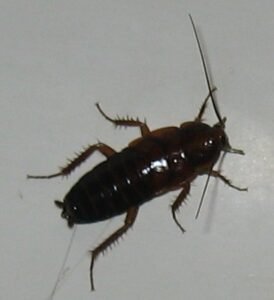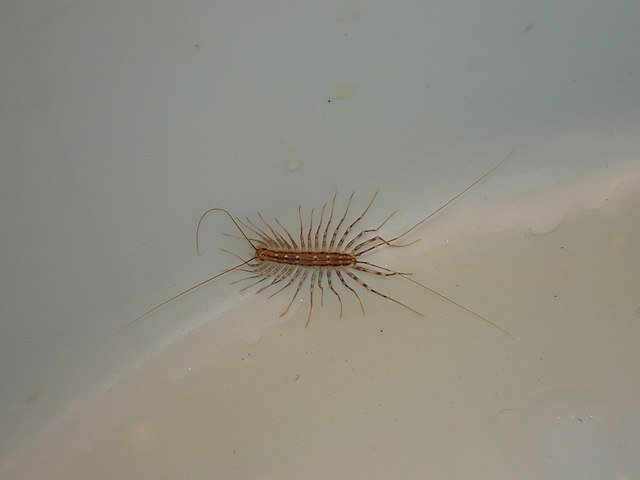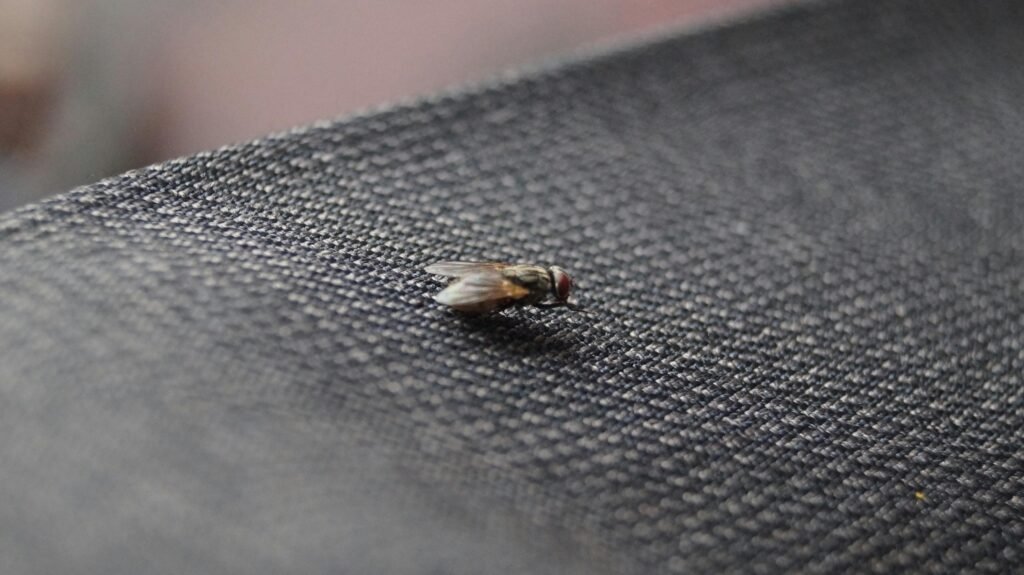Oriental Cockroach (Blatta orientalis)
 The oriental cockroach (Blatta orientalis), sometimes called the "water bug" or "black beetle cockroach," is a large, dark species commonly found in damp environments. Unlike the German cockroach (Blattella germanica), which thrives in kitchens and apartments, the oriental cockroach prefers basements, drains, crawl spaces, and other moist areas.
The oriental cockroach (Blatta orientalis), sometimes called the "water bug" or "black beetle cockroach," is a large, dark species commonly found in damp environments. Unlike the German cockroach (Blattella germanica), which thrives in kitchens and apartments, the oriental cockroach prefers basements, drains, crawl spaces, and other moist areas.
This species is often associated with unsanitary conditions, not only because of its habitat but also due to the strong odor it produces. Known for its slow movement and glossy dark body, it remains one of the most unpleasant cockroaches encountered in households and businesses.
This article provides a comprehensive overview of Blatta orientalis—its biology, ecology, risks, distribution, and the most effective control strategies.
Identification
Size: Adult males measure 18–25 mm, while females are slightly larger at 20–27 mm.
Color: Shiny dark brown to black, giving them a beetle-like appearance.
Wings:
Males: Short wings covering about three-quarters of the abdomen.
Females: Much shorter wings, appearing almost wingless.
Behavioral Traits:
Slow-moving compared to American cockroaches (Periplaneta americana).
Strong, musty odor noticeable in heavy infestations.
Prefers cool, damp environments rather than hot, dry areas.
Their sluggish movement and dark coloring make them easy to distinguish from other household roaches.
Biology and Ecology
The oriental cockroach has unique biological traits that support its survival in damp environments:
Life Cycle:
Females produce oothecae containing 16–18 eggs.
Egg cases hatch within 60 days.
Nymphs require 6–12 months to reach adulthood, much slower than German cockroaches.
Adults live around 6 months.
Feeding Habits:
They are scavengers that consume:Decaying organic matter.
Garbage and food scraps.
Pet food, crumbs, and grease.
In some cases, paper and fabrics.
Environmental Preferences:
Thrive in moist, dark places.
Commonly found in floor drains, basements, sewers, and under mulch outdoors.
Tolerate cooler temperatures better than many other cockroach species.
Global Distribution
Blatta orientalis is cosmopolitan, with established populations across multiple regions:
North America: Found in most states, especially in older urban areas.
Europe: Widespread in cities with aging infrastructure, where drains and sewers provide shelter.
Asia: Native to regions around the Caspian and Black Seas but spread throughout India, China, and Southeast Asia.
Africa and South America: Well established in urban centers.
Its adaptability to sewers and drainage systems makes it particularly common in cities with old plumbing.
Risks and Damage
Oriental cockroaches are considered a major public health concern:
Food Contamination: They carry bacteria such as E. coli and Salmonella.
Allergens: Shed skins and droppings can trigger asthma and allergies, especially in children.
Odor: Their strong smell contaminates food and surfaces.
Psychological Stress: Like bed bugs (Cimex lectularius), they cause distress, insomnia, and embarrassment.
Secondary Infestations: By contaminating food, they can also attract other pests such as ants or flies.
Signs of Infestation
Live Sightings: Large, dark roaches seen in basements, drains, or bathrooms.
Egg Cases (Oothecae): Brown capsules about 8–10 mm long, often found near damp areas.
Droppings: Dark specks resembling black pepper, found along baseboards or near water sources.
Odor: A strong, foul smell noticeable in infested rooms.
Control Methods
1. Sanitation
Eliminate food scraps and garbage.
Clean drains and plumbing fixtures regularly.
Store food in sealed containers.
2. Exclusion
Seal cracks in walls and floors.
Repair leaking pipes and improve ventilation.
Install drain covers and door sweeps.
3. Chemical Control
Gel Baits: Effective when placed near drains, baseboards, and crawl spaces.
Residual Insecticides: Cockroach control with pesticides applied in cracks, crevices, and damp hiding spots.
Dusts (e.g., boric acid, diatomaceous earth): Useful in hard-to-reach areas.
4. Professional Pest Management
Oriental cockroach infestations often require licensed exterminators due to the pests’ ability to hide deep within drainage systems.
Advanced Approaches
Integrated Pest Management (IPM): Combines sanitation, monitoring, and selective chemical treatments.
Biological Control: Some research has tested parasitic fungi and nematodes with promising results.
Heat and Cold Treatments: Extreme temperatures can kill cockroaches in enclosed environments.
Smart Monitoring Devices: Sticky traps with pheromone lures help track infestations more precisely.
Cultural and Historical Context
Unlike honey bees (Apis mellifera), which are admired for their role in pollination, cockroaches carry a negative cultural reputation.
In folklore, roaches often symbolize decay, dirtiness, or resilience.
The oriental cockroach’s association with sewers and filth amplifies its stigma.
In literature and film, cockroaches (including Blatta orientalis) are often portrayed as metaphors for survival in hostile environments.
FAQ
Q1: Are oriental cockroaches dangerous?
Yes. They spread bacteria, worsen allergies, and contaminate food.
Q2: What do oriental cockroaches look like?
They are large, dark brown to black, with short wings (males longer than females).
Q3: Where are oriental cockroaches commonly found?
In drains, sewers, basements, crawl spaces, and other damp environments.
Q4: Do oriental cockroaches fly?
No. Despite having wings (males), they cannot fly.
Q5: How can I get rid of oriental cockroaches naturally?
Boric acid, diatomaceous earth, and thorough cleaning help reduce populations.
Q6: Why are oriental cockroaches sometimes called “water bugs”?
Because they thrive in damp areas like drains and sewers, often near water sources.
Final Thoughts
The oriental cockroach (Blatta orientalis) is one of the most unpleasant cockroach species encountered indoors. Its large size, dark glossy body, and foul odor make it instantly recognizable, while its preference for damp environments such as drains, basements, and crawl spaces makes eradication challenging. Unlike the faster-moving German cockroach, the oriental cockroach reproduces more slowly but can still establish large infestations if conditions are favorable.
Successful management depends on a multi-step approach: sanitation to remove food sources, exclusion to limit entry points, and carefully applied baits and insecticides. In many cases, professional pest control services are required because oriental cockroaches often hide deep in sewer systems and other inaccessible locations.
Although this species has earned a reputation for filth, it also demonstrates how adaptable cockroaches are as a group. Understanding their biology and habits is essential not only for elimination but also for long-term prevention.
Learn more about other Urban & Indoor Pests that affect our houses and buidings.
Disclaimer
This article is for informational purposes only. Pest control laws and approved chemicals vary by country. For best results and legal safety, we strongly recommend contacting a licensed pest control professional in your local area. Always make sure that the pest control technician is properly certified or licensed, depending on your country’s regulations. It’s important to confirm that they only use approved products and apply them exactly as instructed on the product label. In most places in Europe, UK, or USA, following label directions is not just best practice—it’s the law.
Author Bio
Nasos Iliopoulos
BSc Agronomist & Certified Pest Control Expert
Scientific Director – Advance Services (Athens, Greece)
Licensed Pest Control Business – Ministry of Rural Development & Food (GR)
References
University of Maryland - Cockroaches
Wikipedia - Oriental cockroaches
Cornwell, P. B. (1968). The Cockroach. London: Hutchinson.


